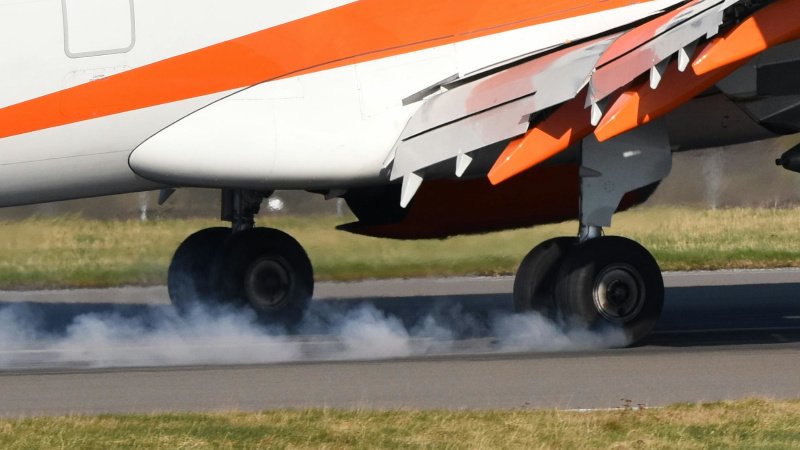Aircraft Tire Speed Ratings: Ensuring Safety at High Speeds

What is Aircraft Tire “Speed Rating”?
- The speed rating is the maximum ground speed the tire is designed to withstand safely under its rated load and pressure.
- It ensures the tire won’t overheat, distort, or fail due to centrifugal forces, heat buildup, or tread separation during high-speed operation.
- For example:
- A general aviation tire might be rated for 120–160 mph.
- A Boeing 747 main tire can be rated for 235–250 mph.
- Some supersonic aircraft (like Concorde) had tires tested well over 270 mph ground speed.
- A general aviation tire might be rated for 120–160 mph.
How is Speed Rating Calculated & Tested?
Aircraft tire speed ratings are not just estimated — they’re verified under strict test conditions:
- Laboratory High-Speed Tests (per FAA/EASA/SAE standards):
- The tire is mounted on a test wheel, inflated to rated pressure, and loaded to rated weight.
- It is then run on a dynamometer (rolling drum) at increasing speeds.
- It must survive:
- Sustained running at the rated speed.
- Over-speeds (typically +10% or more) without failure.
- Sustained running at the rated speed.
- The tire is mounted on a test wheel, inflated to rated pressure, and loaded to rated weight.
- Heat Considerations:
- Tires must not exceed safe temperature thresholds in tread and casing.
- Excess heat causes rubber reversion (softening), casing weakening, and potential blowout.
- Tires must not exceed safe temperature thresholds in tread and casing.
- Centrifugal Growth:
- At high RPM, the tread wants to “grow” outward. Plies and belts restrain this growth.
- Speed rating ensures this expansion does not exceed structural limits.
- At high RPM, the tread wants to “grow” outward. Plies and belts restrain this growth.
How Are Speed Ratings Expressed?
- Usually given in miles per hour (mph) or kilometers per hour (km/h).
- Examples:
- 160 mph for a Cessna Caravan tire.
- 225 mph for a business jet tire.
- 250+ mph for large transport category jets.
- 160 mph for a Cessna Caravan tire.
- Ratings are tied to tire size, ply rating, and load capacity. A larger, stronger tire can usually carry more weight at higher speeds.
Is Speed Rating Regulated?
Yes, very tightly regulated.
- FAA (Federal Aviation Administration, USA):
- Standards in TSO-C62 (Technical Standard Order) and AC 20-97B specify testing for tire speed, load, and endurance.
- Standards in TSO-C62 (Technical Standard Order) and AC 20-97B specify testing for tire speed, load, and endurance.
- EASA (Europe):
- Follows equivalent regulations based on ICAO & SAE standards.
- Follows equivalent regulations based on ICAO & SAE standards.
- SAE Aerospace Standards (AS501/AS1339):
- Provide test procedures for determining speed and load ratings.
- Provide test procedures for determining speed and load ratings.
- Aircraft Certification Basis (CS-25 / FAR Part 25):
- Requires manufacturers to demonstrate that selected tires meet or exceed required speed ratings for the aircraft’s V1, VR, and rejected takeoff (RTO) speeds.
- Requires manufacturers to demonstrate that selected tires meet or exceed required speed ratings for the aircraft’s V1, VR, and rejected takeoff (RTO) speeds.
Why Speed Rating Matters
- Tires must survive a rejected takeoff (RTO) — the most severe case, where the aircraft accelerates to near takeoff speed and brakes to a stop.
- If the tire can’t handle the speed + load + heat, it may burst — which can cause catastrophic damage.
- That’s why tire selection is critical, and aircraft manuals specify exact approved tires with certified speed ratings.
Summary
- Speed rating = max safe ground speed under rated load & pressure.
- Determined by lab dynamometer tests, heat tolerance, and structural limits.
- Expressed in mph/kmh, tied to aircraft performance speeds.
- FAA/EASA/SAE strictly regulate these ratings through standards and certification.
- Critical for safety, especially during rejected takeoff scenarios.
